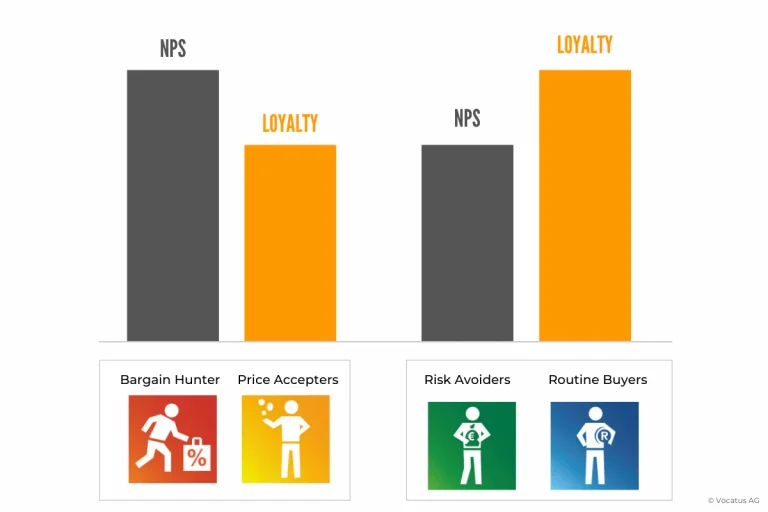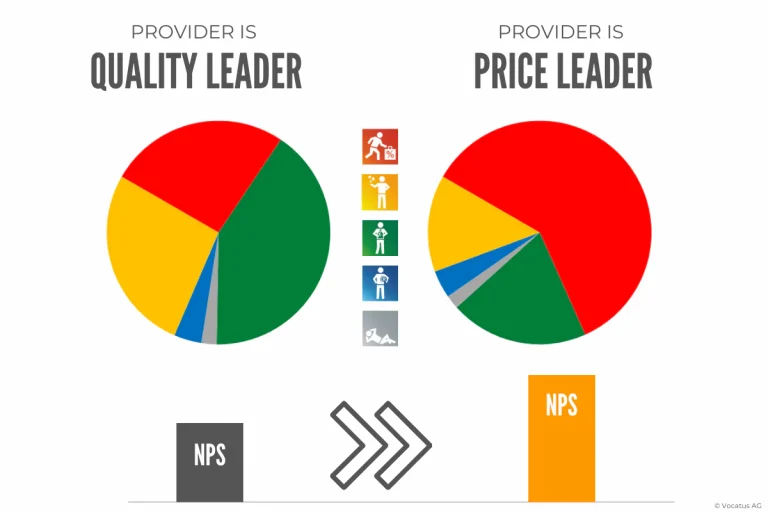The Net Promoter Score (NPS) is particularly notable for its simplicity. The customer is asked just one question: “How likely are you to recommend Company X to others?” Then, those who answer 0 to 6 are subtracted from those who answer 9 or 10. The result is the Net Promotor Score.
Founder Fred Reichheld believed he had discovered an empirical correlation between this number and company growth. However, his findings could not be replicated even in an extensive empirical study conducted by MIT. No correlation between Net Promoter Score and company growth could be found (MIT Sloan Management Review, 2008)
And this is not surprising…
The following assumptions of the Net Promoter Score cannot withstand an empirical investigation:
- Certain performance and service characteristics lead to satisfaction
- Satisfaction leads to recommendation (measuring point of the NPS)
- Recommendation leads to customer loyalty and growth
Why these assumptions of Net Promoter Score cannot withstand investigations
Unfortunately, the world is not that simple because, for many customers, such correlations do not exist. Whether satisfaction leads to recommendation and loyalty is crucially dependent on the type of customer. That is why we have empirically tested the assumptions of the Net Promoter Score for the different customer types, our GRIPS typology. Here you can learn more about the GRIPS Typology.
Involved customers recommend. But that does not mean they are particularly loyal. Two examples:
Bargain Hunters do recommend, but that doesn't mean they are loyal.
The main motive for the bargain hunter is a particularly good price advantage. If this main motive is fulfilled, he is satisfied and often recommends his provider to others. However, this only temporary (price) satisfaction and high recommendation lead to a high level of loyalty only to a very limited extent.
This type of customer re-evaluates his choice with every purchase and then chooses the lowest-priced provider, which is often not the current provider.
Price Accepters are happy to recommend. However, their affinity for switching is high.
Customers who are willing to pay are mainly motivated by excellent performance and outstanding service. However, they are also ready to dig deeper into their pockets. If a company meets the requirements of this customer type in terms of service or the performance offered, this customer type is satisfied and often recommends the provider to others.
However, in this case, satisfaction and recommendation only lead to a limited degree of loyalty. The willingness to change providers is relatively high if, for example, the current provider cannot offer new innovations continuously.
Less involved customers tend not to recommend but, in some cases, are quite loyal...
Risk Avoiders are loyal, but they are not likely to recommend.
The main motive of the loss-aversive customer is fairness and the fit of the product or service to his personal needs. If this main motive is fulfilled, he will be a satisfied and very loyal customer.
However, the loss-aversive customer type does not recommend any particular company as a matter of principle and entirely irrespective of their personal satisfaction and loyalty.
Routine Buyers usually often can not give a reasoned recommendation.
Habitual buyers, on the other hand, are loyal but not very involved. They buy products and services because they have already had good experiences or have always bought them, so they cannot and will not make a reasoned recommendation.
Thus, NPS and loyalty differ greatly depending on the type of customer:


No correlation between Net Promoter Score and loyalty
A low NPS does not have to be a warning sign
The Net Promoter Score does not provide a valid prediction of customer loyalty for any of the four customer types. Managing one’s business according to this number will unlikely lead to meaningful results.
The different behavior of the various customer types can lead to absurd results for the Net Promoter Score. As illustrated in the following chart, the Net Promoter Score can be larger or smaller depending on the distribution of customer types. Thus, a low Net Promoter Score should not immediately be seen as a warning signal.

By changing the composition of the customer types, the Net Promoter Score can also be increased substantially. Especially if the main motive for customer loyalty is, for example, the lowest price in the market, which contradicts the corporate strategy (e.g., quality leadership), it becomes clear that an undifferentiated NPS value cannot be a meaningful target figure (KPI).
The combination of GRIPS and Net Promoter Score leads to reliable measurement of customer loyalty
Net Promoter Score alone cannot validly predict customer behavior. But if you do not know the cause, you cannot take targeted measures for improvement. The consequences are senseless actionism and inefficient use of resources.
To reliably predict customer loyalty, the Net Promoter Score must be considered in the context of the customer types at hand.
The additional GRIPS survey shows whether or not there is a need for action and which measures can increase customer loyalty. After all, no company should unthinkingly plunge into a price war just to increase the Net Promoter Score among bargain hunters.

If you would also like to find the best pricing model for you, please feel free to contact us directly for an individual consultation. Just send us an email to consulting@vocatus.de or a message via our contact form.




